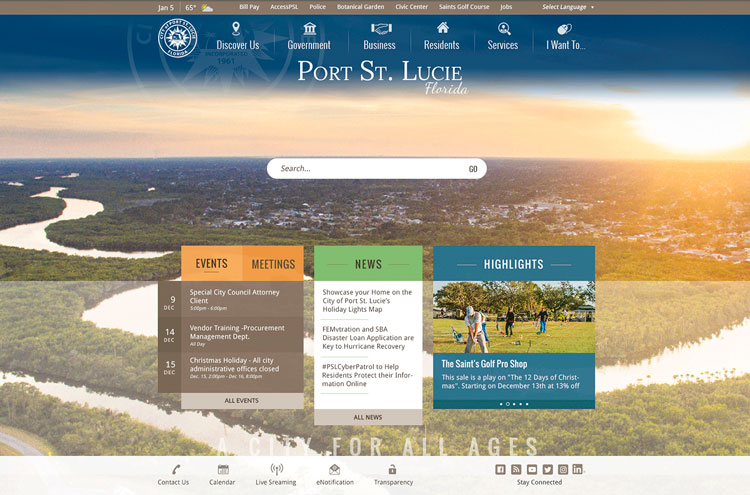Thank you!
Government Website Design: Federal, State & Local Web Design and Development
Vision, a leader in government website design, is now Granicus govAccess.
Visit govAccessHow does government website design differ from the private sector?
Government website design refers to a specialized approach to building a CMS (or government content management system) that manages the creation and storage of digital content by a government organization.
Citizens have come to expect the same effortless experiences they do with private sector website design. Specifically, government website design features must include navigation with search capability, prominently feature top services, offer personalized experiences based on geography, and more.
Unlike those in the private sector, government website design must be driven by citizen behavior, which includes people of all demographics. Whereas the private sector may have a targeted demographic of customers, government website design must serve all people, including those with disabilities. As a result, the most-advanced designs include easy information delivery and task completion that is mobile-friendly, responsive, and accessible. Public sector websites that are informed by data and meet the criteria for citizen-driven design elements lead to higher citizen satisfaction and engagement.
Local government needs to embrace smart website design
Local governments are charged with building stronger communities, and their website is often the first and primary source of information citizens use to enrich their lives – from adopting pets to applying for business licenses.
The top reason that people land on a local government website is to complete a task or transaction, so local government website design must be built with customer journeys in mind and understand how the experience differs by device. For example, if someone is looking up court information from a mobile device, they are likely searching for details like address or phone number, so ensuring that such information is prominently displayed is key.
In summary, local government websites depend on their CMS to be task-oriented and enable citizens to complete that task quickly. Over 1,500 local government organizations depend on govAccess for their local government website design, because they are informed by data and citizen behavior and provide an easy-to-use application for local government leaders.
The importance of being mobile-friendly
Half of all traffic to government websites are on mobile devices—and as more citizens demand on-the-go access to government services, this number is expected to rise sharply. Knowing this, public sector organizations are enhancing their websites to be mobile-friendly, which means that the site adapts to a mobile screen, is accessible and readable, and provides a simpler navigation.
Device usage is an important metric to monitor for several reasons. Most importantly, it shows how users are accessing government website designs and how those experiences differ by device. The govAccess team is constantly monitoring new design methods for optimization when it comes to mobile use and can help identify pages with higher mobile traffic to prioritize enhancements to the experience for such users.
How important is a flexible CMS to a public sector website? Very.
Governments that are leading the way with their digital presence understand the power of a service-minded approach to their website design. These organizations view every website interaction as an opportunity to learn how to better serve their citizens digitally. They also build their website on a flexible CMS, so they can act on insights and continuously improve the citizen experience.
The best government websites are well organized, content-rich, and highly searchable. To best optimize a service-oriented government website, content that is clear and utilizes plain language can lead to improved results.
Taking a collaborative approach that meets every government’s unique needs
Every community is different and has unique needs and priorities. The govAccess team uses a collaborative process – seeking government input and approval along the way. In the end, our designs incorporate these special attributes and features of each community, ensuring a professional, beautiful website that a government organization can be proud of.
For more information on government website design, visit the govAccess page.

